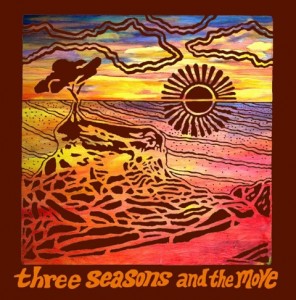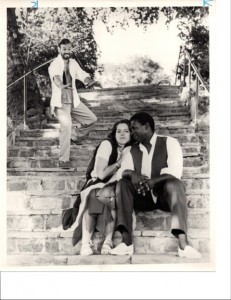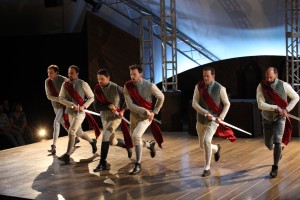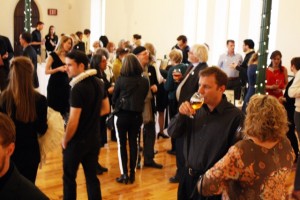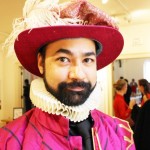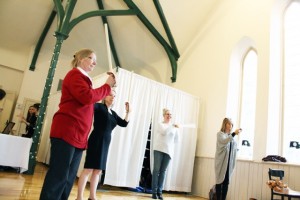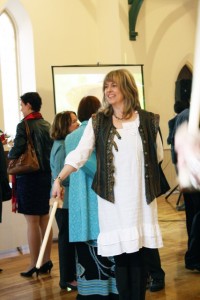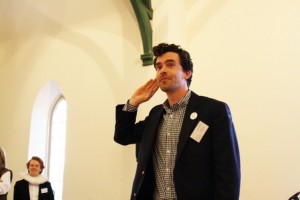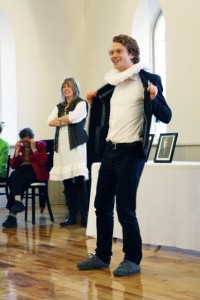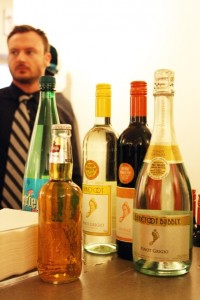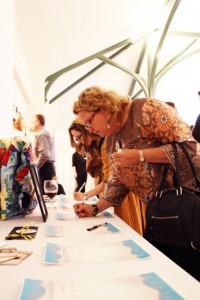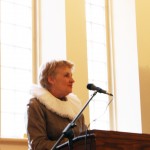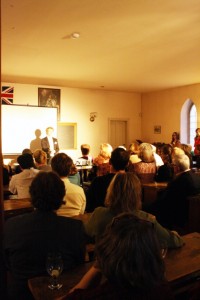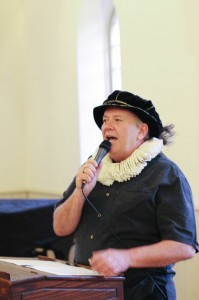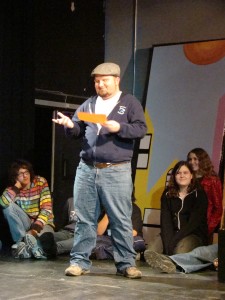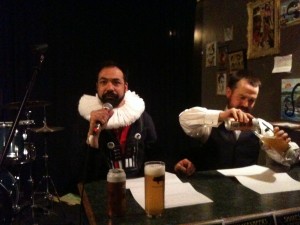University of Alberta professor, David Ley’s, shares his exciting way into teaching and speaking Shakespeare. David uses the words of Dr. Seuss to help actors find and use the rhetorical structures Shakespeare provides. It may seem like a strange pairing, but here David explains to us the impact it has on the way actors understand and take hold of language.
How did you come up with this technique? What made you connect Seuss with Shakespeare?
I did a lot of reading to my own kids and since I’m interested in pattern identification I think I began hearing it; I have a mind that naturally compares and contrasts. All teaching looks for deep structure – what are we trying to get at underneath it – and so I think that’s where it all began.
I take my students to go and read to Junior Kindergarten classes and I do that because the thing that is going to hold our interest when we’re 4 is the same as when we’re 40 or 80. The ‘I Can Read’ series by Dr. Seuss should be called the ‘I Can Communicate’ series. I’ve always been interested in rhetoric and Seuss & Shakespeare each highlight different rhetorical structures. Dr. Seuss invites a playfulness that’s often missing in Shakespeare, as well as the willingness to engage in playfulness.
I think both are brilliant and people often say that in 400 years we’ll still be reading Dr. Seuss… We have become denotative… For example, the word, “ocean” can be so many different things, from a big wonderful place to a terrifying place. Seuss teaches us how to express these things – big or small, far or near, good or bad, but we often fail to give this information in the support of our communication.
What can Seuss teach us about Shakespeare’s words? Structure? Rhetoric?
I love Sister Miriam Joseph’s books (Shakespeare’s Use of the Arts of Language) and books that list endless numbers of forms of rhetoric. When an actor picks that up, when you embrace it and you invest in it, it actually takes you somewhere bigger. In repetition, for example, what a modern actor will do is make them all different because they’ll go, “I can’t be all the same,” so what they’ll do is take it apart and spread it out on the field instead of stacking it. When you stack and you stack and you stack, you realize the power of repetition… So, there’s the aspect of repetition, there’s the breadth of antithesis; you can pitch tag an argument:
‘Shall I compare thee to a summer’s day?’ Now as I continue through that speech, I actually now know that when I hit this pitch I’m talking about you and when I hit this pitch, I’m talking about the summer’s day. If I’m talking about apples and oranges it’s different than apples and jumbo jets. Then I would have to have a greater range in my voice to tell you that the things that I’m comparing are much further apart. So, things like that help the audience follow the language.
Articulation is another thing. I’m old fashioned because I always say let’s see what it’s like if we just pronounce all the consonants… We use, in a way, the Dr. Seuss to see how much people are accustomed to investing in sounds, so that the quality of the sound itself has an inherent action in it: “Love is not love which alters when it alteration finds.” If you don’t do the “v” on “love”, “luffing” is something a sail does when there’s no wind in it. I think if an actor invests in the word, if you look somebody in the eye and say, “I love you,” and you commit to every sound of that word, you’re actually going to feel something. Then the text can actually take you somewhere, you don’t have to make something of it – it can actually take you for a ride.
What has been the response of actors in using this approach? How has it changed their attitude toward or facility with Shakespearean text?
I’ve done this in front of Martha Henry and in front of school teachers and the response is always great. First of all, it’s a great diagnostic to find out what your habits are – what you do, what you don’t do… What’s neat about it is that it’s worked with high school kids, it’s worked with school teachers, with student actors and it’s worked with professionals. And also, it’s fun… people pick up Shakespeare and get all serious about it, we get all academic with it. The point is that we are taking what is ultimately an academic study (of rhetoric) and we’re applying it in a way which is fun. You know, kids’ books are great, all sorts of kids books, because in kid’s books you find books that are meant to be read aloud. Shakespeare was not meant to be read silently. I don’t think Shakespeare wrote Romeo & Juliet for some academic to go sit down in his quiet office while he listens to Chopin and works his way through that structure. Those words were meant to be spoken by somebody to somebody else. And the only words that we find like that now, besides some poetry, are kids’ books.
This stuff only works when you make people sit on the floor and pretend they’re three years old. It’s surprising how much people actually want to do that. So, it becomes a really fun little exchange where people are behaving like they’re three and responding to the reader like they’re three, which actually makes the reader have more fun. And then they take out their Shakespeare and there’s much more life, there’s much more dynamic expression and range in the way they present that text.
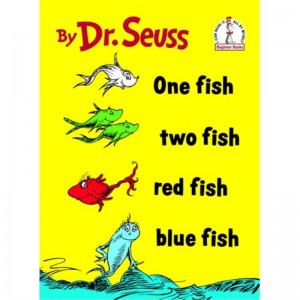
Photo credit: http://www.adoremusbooks.com/onefishtwofishredfishbluefish.aspx
One of the great books is One Fish, Two Fish, Red Fish, Blue Fish – it’s the gold standard, it’s the ‘take the pebble from my hand’ book. What’s interesting is you actually have to coach actors to identify the patterns. So, what do we have to do when we’re reading that book?
Here’s one example: you have to encourage people to finish final consonants. I’m a voice coach and what do I have to do more than anything? Encourage people to finish final consonants, don’t drop the energy at the end of the line. That’s what I say more than anything else. “Say! Look at his fingers! One, two, three… how many fingers do I see?” We get people reading it really flat. But “three” is more than “one” so you have to tell people, “can I hear in your voice that three is more than one?” Then, the fact that he has eleven fingers is a big discovery, because you’ve built up to that. But modern actors, even at a pretty high level, are not going to do that, so they’re not going to get that wonderful discovery that happens, because they haven’t explored what it means for eleven to be more than one.
Then, there’s any number of pieces of Shakespeare that you can find that have that kind of repetition in them. Claudius’s ladder of thought in Hamlet is a classic example.
Do the Dr. Seuss, then do the Claudius one:
“Say! Look at his fingers! One, two, three… how many fingers do I see? One, two, three, four, five, six, seven, eight, nine, ten, he has eleven! Eleven! This is something new. I wish I had eleven, too!” (One Fish, Two Fish, Red Fish, Blue Fish)
“Give me the cups,
And let the kettle to the trumpet speak,
The trumpet to the cannoneer without,
The cannons to the heavens, the heaven to earth,
Now the King drinks for Hamlet.” (Hamlet 5.2.)
Do you have a favourite line from each of these writers?
A favourite line from Seuss… maybe: ‘Unless someone like you cares a whole awful lot, nothing is going to get better, it’s not’ (The Lorax). Also fond of the book: Oh, The Places You’ll Go! It’s full of wonderful philosophy, which takes me to, ‘To thine own self be true, And then it must follow, as the night the day, thou canst not then be false to any man.’ (Hamlet). We get the philosophy of both writers giving advice to young men going out into the world. I have sons.
David Ley holds an MFA in performance from York University with a diploma in Voice Teaching. He is a Professor in the Drama Department at the University of Alberta where he teaches Voice and Speech, Dialects, and Acting. David has extensive experience in private practice teaching vocal skills to a wide array of professional voice users from schoolteachers to politicians and has taught many voice workshops both across Canada and abroad. He spent ten seasons as a Voice Coach at Canada’s Stratford Festival and continues to be a regular instructor in Stratford’s Birmingham Conservatory. He has done numerous feature newspaper interviews commenting on dialects and vocal performance and has been featured in two CBC documentaries on Canadian speech. Media outlets around the world have covered his work on the Vibrant Voice Technique including: The Toronto Star, The Globe and Mail, The Guardian UK, the Huffington Post, Metro News International, and many others. David has 30 years of experience working as an actor in theatres across Canada and has acted in numerous film and television productions.


